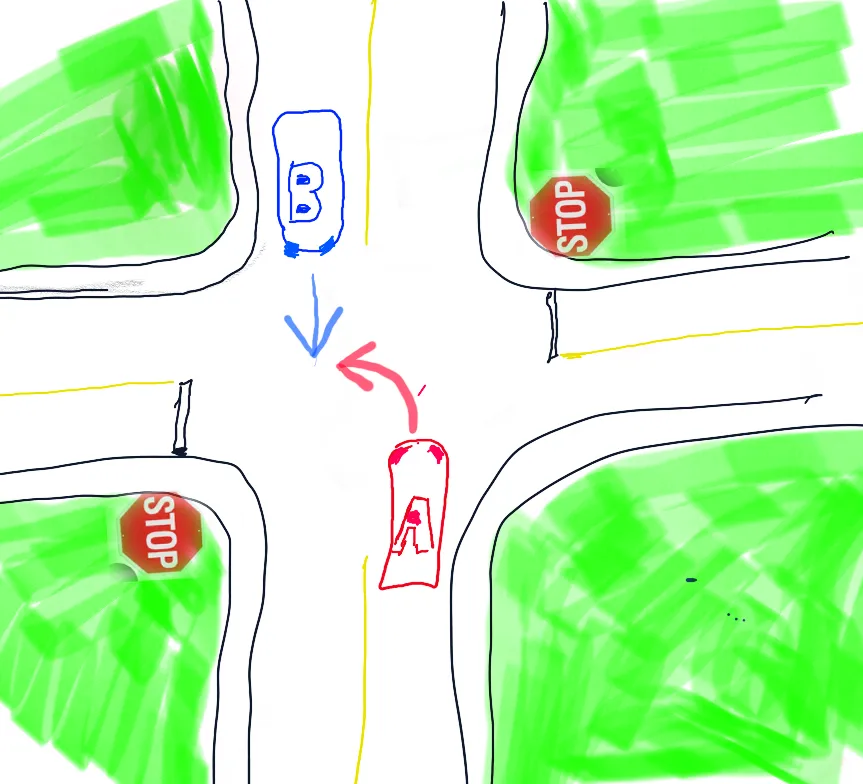GO SEE ICBC’s DISCUSSION OF THIS CRASH
CAR A – 100% AT FAULT CAR B – 0%
- 19 OPENING VEHICLE DOOR IN TRAFFIC
- 18
- 17 PARKING LOT MAIN LANE VERSUS FEEDER LANE
- 16 CRASH EXITING PARKING LOT OR DRIVEWAY
- 15 LEFT TURN CRASH ONCOMING PASSING CAR
- 14 LEFT TURN VEHICLE PASSING ON YOUR LEFT
- 13 CRASH MAKING LEFT AT INTERSECTION, VEHICLE PASSING
- 12 COMMERCIAL VEHICLE MAKING WIDE RIGHT TURN
- 11 VEHICLE MAKING RIGHT TURN WIDE
- 10 REVERSE TURN (UTURN) CRASH
- 09 LEFT TURN CRASH WITH CURB LANE TRAFFIC
- 08 LEFT TURN CRASH WITH ONCOMING TRAFFIC
- 07 HIGHWAY MERGE CRASH
- 06 CRASH BOTH VEHICLES CHANGING LANES
- 05 CRASH WHILE CHANGING LANES
- 04 WHEN A VEHICLE CROSSES CENTER LINE
- 03 STATIONARY VEHICLE CRASH
- 02 REAR END CRASH TWO CARS
- 01 READ ENDER
174 yielding right of way on left turn
174 When a vehicle is in an intersection and its driver intends to turn left, the driver must yield the right of way to traffic approaching from the opposite direction that is in the intersection or so close as to constitute an immediate hazard, but having yielded and given a signal as required by sections 171 and 172, the driver may turn the vehicle to the left, and traffic approaching the intersection from the opposite direction must yield the right of way to the vehicle making the left turn.
165 Turning at intersections
165 (1) If the driver of a vehicle intends to turn it to the right at an intersection, the driver must cause it to approach the intersection and then make the turn as close as practicable to the right hand curb or edge of the roadway.
(2) When the driver of a vehicle intends to turn it to the left at an intersection where traffic is permitted to move in both directions on each highway entering the intersection, the driver must
(a)cause the vehicle to approach the intersection in the portion of the right side of the roadway that is nearest the marked centre line, or if there is no marked centre line, then as far as practicable in the portion of the right half of the roadway that is nearest the centre line,
(b)keep the vehicle to the right of the marked centre line or centre line of the roadway, as the case may be, at the place the highway enters the intersection,
(c)after entering the intersection, turn the vehicle to the left so that it leaves the intersection to the right of the marked centre line of the roadway being entered, or if there is no marked centre line then to the right of the centre line of the roadway being entered, and,
(d)when practicable, turn the vehicle in the portion of the intersection to the left of the centre of the intersection.
(3) When the driver of a vehicle intends to turn the vehicle left at an intersection where traffic is restricted to one direction on one or more of the highways, the driver must cause the vehicle to approach the intersection in the extreme left hand lane available to traffic moving in the direction of travel of the vehicle, and after entering the intersection turn the vehicle to the left so as to leave the intersection as nearly as practicable in the left hand lane available to traffic moving in the direction of travel of the vehicle on the highway being entered.
(4) If at an intersection there is a traffic control device indicating the course to be travelled by vehicles turning at the intersection, a driver must turn a vehicle at the intersection in the manner directed by the traffic control device.
(5) A person must not turn a vehicle at an intersection unless it is in the position on the highway required by this section.
CERTAINLY, SOMETHING ALL DRIVING LESSONS MUST ENSURE IS CRYSTAL CLEAR.






Comments are closed